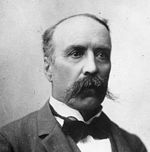Jesús María (Ocampo)
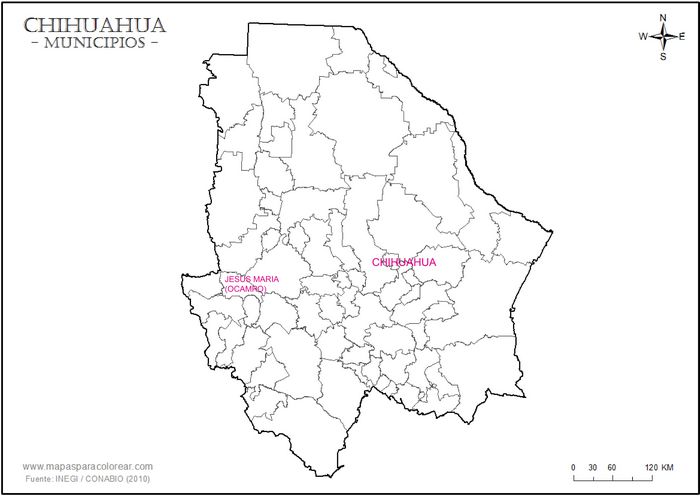
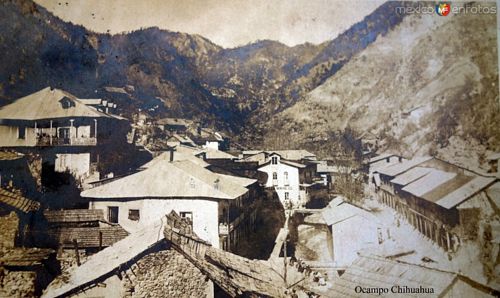
Ocampo, 1905
Santa Juliana mine
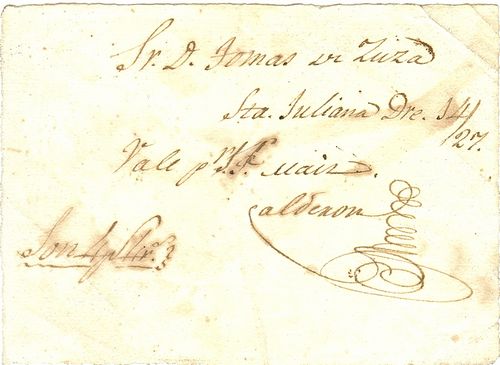
An early example of scrip is a handwritten note drawn on Tomás de Zuza, in Santa Juliana, Jesús María (renamed Ocampo in 1902), dated 14 December 1827 with the inscriptions Vale por [ ] maiz. Tomás de Zuza was born in Tajonar, Pamplona, in 1775. He settled in Sonora and was one of the first owners of the mines at Mulatos in 1807, and later mined in El Rosario and Jesús María. Tomás de Zuza and Tomás Rivera owned the Nuestra Senora del Rayo mine and were part-owners of the Santa Juliana mine in Jesús María. They worked the Rayo mine successfully, with good results, in gold and silver but abandoned it on the discovery of a bonanza in the Santa Juliana mine in 1826.
De Zuza held various public offices, and in 1828 was exempted from the expulsion of Spaniards. He finally moved to Chihuahua and died in 1845.
In 1894 a Mexico City newspaper reported that before the law prohibiting payments in scrip (fichas, cacharpas, vales al portador y otros objetos) came into effect, the practice was rife but now people were paid in legal tender. However, in Ocampo it appeared that the law was less efective, given the great circulation of aluminium tokens (monedas ó contraseñas de aluminio) issued by the Compañía Minera de Santa Juliana, redeemable only in the tienda de raya for highly-priced goods. Any worker who needed banknotes to pay his taxes etc. had to sell the tokens at a 25% discount to other businesses as the tienda did not exchange them at any priceVoz de México, Mexico, 4 August 1894.
Francisco Córdova
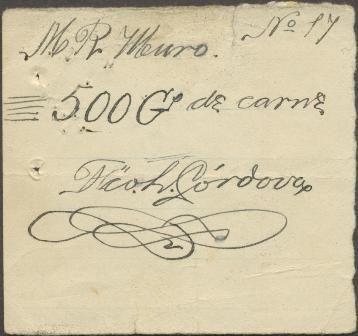
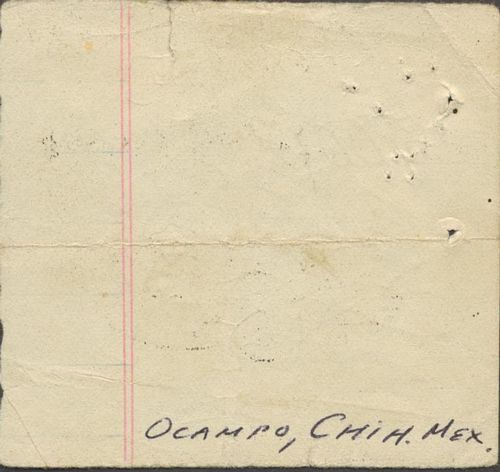
Another example is a small handwritten vale on lined paper with the text ‘M R Meuro No 17 / 500g de carne / Fr'co. W. Cordova’ and the annotation ‘OCAMPO, CHIH’ on the reverse.This is an instruction either to M. R. Meuro or more likely to someone tp provide M. R. Meuro with 500 grammes of meat. (A similar instruction is found on various 50c notes of the Compañía Minera of Uruachic
The annotation, if correct, would locate this note in Chihuahua. Rafael and Francisco Córdova had owned the San Vicente mine in Jesús María before 1887Periódico Oficial, 21 September 1887. A Francisco Cordova, from Ocampo, is recorded in 1909Periódico Oficial, 14 March 1909 and was elected Regidor 3a suplente of Ocampo for 1912Periódico Oficial, 19 May 1912.
Negociación de Santa Eduwiges
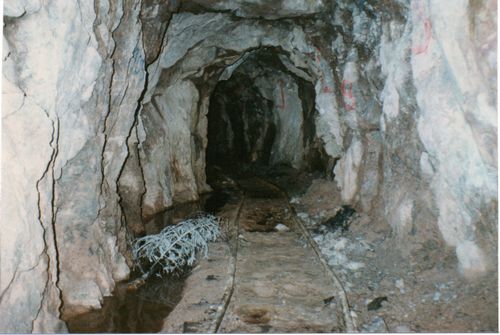 The Santa Eduwiges mine is situated a couple of miles outside the town of Jesús María (Ocampo). In the 1880s it was owned by a former governor of Colorado, Horace Tabor.
The Santa Eduwiges mine is situated a couple of miles outside the town of Jesús María (Ocampo). In the 1880s it was owned by a former governor of Colorado, Horace Tabor.
The Negociación de Santa Eduwiges (misspelt Negociation on the notes) issued scrip payable in cash in Jesús María and Chihuahua and accepted by nine stores (casas comerciales) in Jesús María, though the local government declared that they were not officially sanctionedFrancisco Almada, Apuntes Históricos de la Región de Chínipas, Chihuahua, 1937. Two series are known.
First series
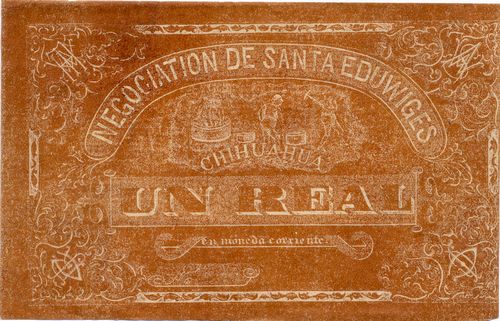
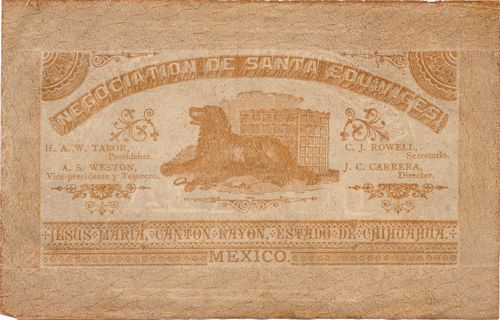
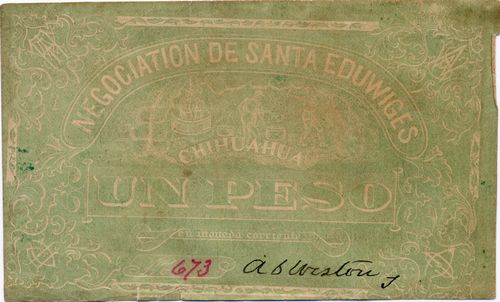
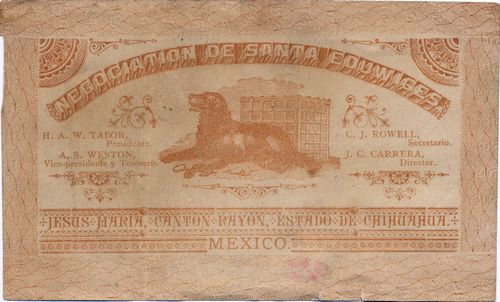
| from | to | total number |
total number |
||
| ½r | |||||
| 1r | |||||
| 2r | |||||
| 4r | |||||
| $1 | includes number 673 |
The first series (sequenced simply on the basis that Weston's signature (if legitimate) is hand-signed on these notes and a facsimile on the second series) bear a striking resemblance to the Pinos Altos notes, whilst the common reverse has a vignette of a dog guarding a strongbox and the printed names of H. A. W. Tabor, as President; C. J. Rowell, as Secretary; A. S. Weston, as Vice-president and Treasurer, and J. C. Carrera as Director. Two values (one real and one peso) are known.
|
Tabor built the Tabor Opera House on the main street of Leadville in 1879 in just 100 days, with frescoes on the ceiling, gloriously painted walls, stage curtains that were hand-painted, and custom carpets, to bring arts and culture to a cold, remote mining town. It was known as "the most perfect place for amusement between Chicago and San Francisco" and its performers included Harry Houdini and Oscar Wilde. Tabor purchased the Santa Eduwiges mine in 1884 and boasted “My Colorado mines are nothing compared with this Mexican bonanza, as it seems to be practically inexhaustible"Daily Herald, Leadville, 7 May 1884. Unfortunately, he became embroiled in a court dispute with his Mexican partners over the ownership of the mine. He finally gained control in 1893, but that year the silver panic and subsequent passage of the Sherman Silver Purchase Act devastated his fortune. Tabor hoped that the Santa Eduwiges would save his collapsing mining and business empire and he personally travelled to Mexico to oversee its functions. Sadly, by mid-1894 even this effort had failed. The expenses of dead work, heavy equipment, and ordinary operations depleted his already dwindling capital, and “pockety” veins did not produce any steady profits. For Tabor, the Mexican venture proved the final blow to his empire. Practically penniless but still a respected public figure, he was made Postmaster of Denver in 1898, but died of appendicitis in 1899. |
|
|
A.S. Weston arrived in California Gulch, Colorado, the area surrounding Leadville, from Wisconsin, on 14 July 1860 and stayed eleven years working placer mines. After retiring from mining he opened a ranch (at Weston Pass), and for many years was Lake County’s only practicing attorney Bonnie K. Goodman, Silver Boom! The Rise and Decline of Leadville, Colorado as the United States’ Silver Capital, 1860-1896, 2008. He represented the Santa Eduwiges mining company with the state and federal governmentThe Mail, Chihuahua, 19 May 1883; El Siglo Diez y Nueve, 5 June 1883. Later on, Weston was elected a State Senator Bonnie K. Goodman, Silver Boom! The Rise and Decline of Leadville, Colorado as the United States’ Silver Capital, 1860-1896, 2008. Horace Tabor lost his fortune in the Silver Crash of 1893 and Weston bought the Tabor Opera House for $32,000 when the Tabors defaulted on a note to banker A.V. Hunter. In mid-1894 at the urging of friends he renamed the Tabor the Weston Opera House and operated it until his death in early 1897. The judge’s widow Letitia B. Weston continued to operate it until 1901, though she lost ownership in 1899, and by 1904 was without fundsThe Rocky Mountain News, Vol. 45, No. 219, 6 August 1904. |
 |
| Charles J. Rowell was a native Vermonter who moved to Leadville in 1880. He opened a legal practice with A. S. Weston. In May 1882 he was appointed the general business agent at the Tabor Opera HouseGunnison Daily News-Democrat, 6 May 1882 } and was business manager for Tabor’s property for eighteen months. Late in 1883, he resumed his law practice. He became the owner, with Tabor and Weston, of this Santa Eduviges mine and also the owner of valuable mining property in Montana Bonnie K. Goodman, Silver Boom! The Rise and Decline of Leadville, Colorado as the United States’ Silver Capital, 1860-1896, 2008. | |
|
J. C. Carrera was one the best-known mineralogists in the Southwest of the United States and was a professor at the Agricultural and Mechanics College at Mesilla Park, New Mexico. He was a fine linguist, speaking English, French, Spanish and Italian fluently. He lived six years in Paris, and had an extensive acquaintance among the mining and engineering professions throughout the European continentThe Evening Star, 7 February 1900. He was considered as a great authority upon lead and silver properties, and for years much sought after as an expert for mines in Colorado and elsewhere The Mexican Herald, Vol. XVIII, No. 81, 20 May 1904, including throughout Mexico. He organised exhibits at the Chicago, Berlin and Paris World Fairs for New Mexico and Colorado. and owned one of the finest private collection of ores and minerals in the worldThe Mexican Herald, 8 November 1904. When it was exhibited at the Chamber of Commerce in Mexico City, it filled eight large double cases five feet wide and seven feet high, with twenty shelves eachThe Mexican Herald, 1 January 1909. According to his son, Carrera could claim to have “discovered” the Carlsbad Caverns. Sometime before 1885 a sheep man told Carrera about it and took him and a geologist to see the entrance but they did not have a rope so they did not enter. |
Second series
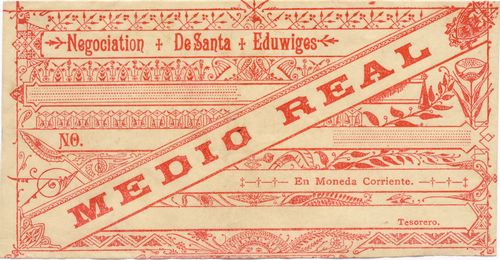
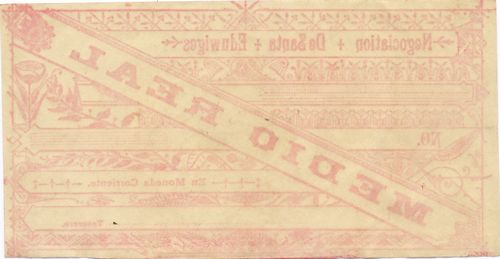
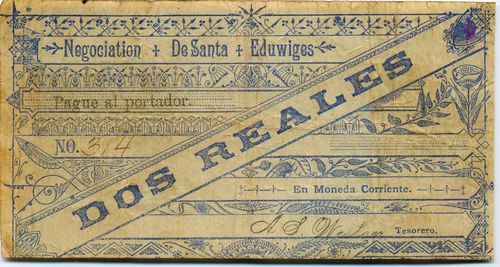
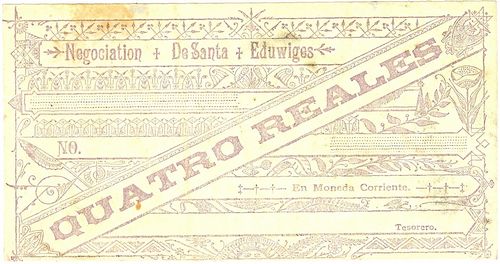
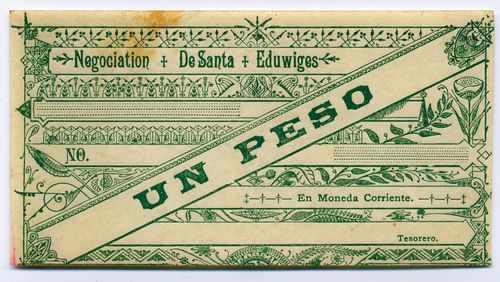
| from | to | total number |
total number |
||
| ½r | includes number 2CNBanxico #10008 | ||||
| 1r | |||||
| 2r | includes number 314CNBanxico #10009 | ||||
| 4r | |||||
| $1 |
Of the second series, four values are known as uniface issued notes or remainders: a red ½r, a blue 2r, a purple 4r and a green $1, all payable en moneda corriente and signed by A. S. Weston, as Tesorero.
La Soledad
La Soledad was a mine about three miles due north of Jesús María which issued notes under the title ‘Negociacion la Soledad-Mineral J. Maria’.
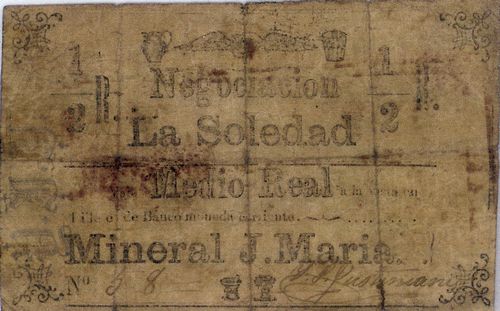
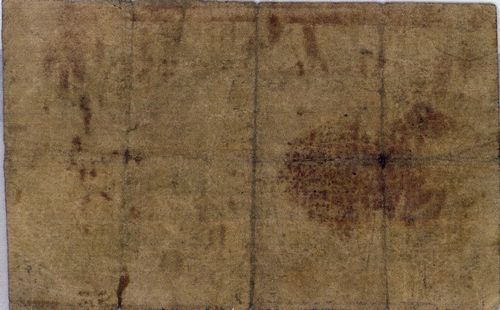
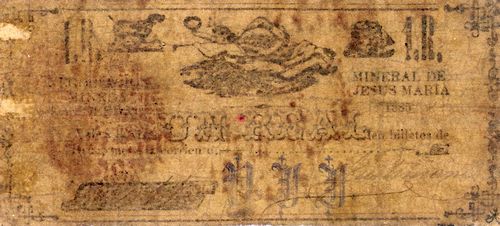
| date on note | from | to | total number |
total value |
||
| ½r | includes number 58 | |||||
| 1r | 1885 |
The two denominations known are ½ real and 1 real, payable on sight in banknotes (a la vista en billete de Banco moneda corriente). Both bear the handwritten signature of Ignacio J. Justiniani.
|
Ignacio. J. Justiniani On 9 August 1887 Justiniani, listed as a miner from Jesús María, together with three others (Jesús Solís, Juan de la Cruz Solís and Rafael Córdova), denounced a continuation to the San Ignacio vein in Los Otates within the Santa Magdalena mine, owned by Jesús Solís and his brothersEl Estado de Chihuahua, Año X, Núm. 59, 27 August 1887. |
 |

